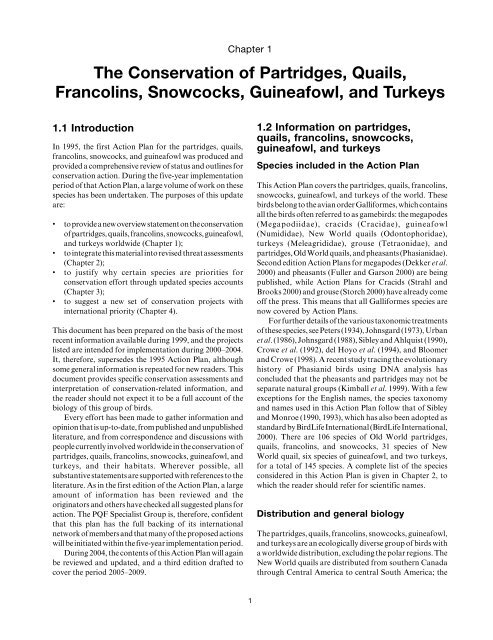Partridges, Quails, Francolins, Snowcocks, Guineafowl, and Turkeys
Partridges, Quails, Francolins, Snowcocks, Guineafowl, and Turkeys
Partridges, Quails, Francolins, Snowcocks, Guineafowl, and Turkeys
Create successful ePaper yourself
Turn your PDF publications into a flip-book with our unique Google optimized e-Paper software.
Chapter 1<br />
The Conservation of <strong>Partridges</strong>, <strong>Quails</strong>,<br />
<strong>Francolins</strong>, <strong>Snowcocks</strong>, <strong>Guineafowl</strong>, <strong>and</strong> <strong>Turkeys</strong><br />
1.1 Introduction<br />
In 1995, the first Action Plan for the partridges, quails,<br />
francolins, snowcocks, <strong>and</strong> guineafowl was produced <strong>and</strong><br />
provided a comprehensive review of status <strong>and</strong> outlines for<br />
conservation action. During the five-year implementation<br />
period of that Action Plan, a large volume of work on these<br />
species has been undertaken. The purposes of this update<br />
are:<br />
• to provide a new overview statement on the conservation<br />
of partridges, quails, francolins, snowcocks, guineafowl,<br />
<strong>and</strong> turkeys worldwide (Chapter 1);<br />
• to integrate this material into revised threat assessments<br />
(Chapter 2);<br />
• to justify why certain species are priorities for<br />
conservation effort through updated species accounts<br />
(Chapter 3);<br />
• to suggest a new set of conservation projects with<br />
international priority (Chapter 4).<br />
This document has been prepared on the basis of the most<br />
recent information available during 1999, <strong>and</strong> the projects<br />
listed are intended for implementation during 2000–2004.<br />
It, therefore, supersedes the 1995 Action Plan, although<br />
some general information is repeated for new readers. This<br />
document provides specific conservation assessments <strong>and</strong><br />
interpretation of conservation-related information, <strong>and</strong><br />
the reader should not expect it to be a full account of the<br />
biology of this group of birds.<br />
Every effort has been made to gather information <strong>and</strong><br />
opinion that is up-to-date, from published <strong>and</strong> unpublished<br />
literature, <strong>and</strong> from correspondence <strong>and</strong> discussions with<br />
people currently involved worldwide in the conservation of<br />
partridges, quails, francolins, snowcocks, guineafowl, <strong>and</strong><br />
turkeys, <strong>and</strong> their habitats. Wherever possible, all<br />
substantive statements are supported with references to the<br />
literature. As in the first edition of the Action Plan, a large<br />
amount of information has been reviewed <strong>and</strong> the<br />
originators <strong>and</strong> others have checked all suggested plans for<br />
action. The PQF Specialist Group is, therefore, confident<br />
that this plan has the full backing of its international<br />
network of members <strong>and</strong> that many of the proposed actions<br />
will be initiated within the five-year implementation period.<br />
During 2004, the contents of this Action Plan will again<br />
be reviewed <strong>and</strong> updated, <strong>and</strong> a third edition drafted to<br />
cover the period 2005–2009.<br />
1.2 Information on partridges,<br />
quails, francolins, snowcocks,<br />
guineafowl, <strong>and</strong> turkeys<br />
Species included in the Action Plan<br />
This Action Plan covers the partridges, quails, francolins,<br />
snowcocks, guineafowl, <strong>and</strong> turkeys of the world. These<br />
birds belong to the avian order Galliformes, which contains<br />
all the birds often referred to as gamebirds: the megapodes<br />
(Megapodiidae), cracids (Cracidae), guineafowl<br />
(Numididae), New World quails (Odontophoridae),<br />
turkeys (Meleagrididae), grouse (Tetraonidae), <strong>and</strong><br />
partridges, Old World quails, <strong>and</strong> pheasants (Phasianidae).<br />
Second edition Action Plans for megapodes (Dekker et al.<br />
2000) <strong>and</strong> pheasants (Fuller <strong>and</strong> Garson 2000) are being<br />
published, while Action Plans for Cracids (Strahl <strong>and</strong><br />
Brooks 2000) <strong>and</strong> grouse (Storch 2000) have already come<br />
off the press. This means that all Galliformes species are<br />
now covered by Action Plans.<br />
For further details of the various taxonomic treatments<br />
of these species, see Peters (1934), Johnsgard (1973), Urban<br />
et al. (1986), Johnsgard (1988), Sibley <strong>and</strong> Ahlquist (1990),<br />
Crowe et al. (1992), del Hoyo et al. (1994), <strong>and</strong> Bloomer<br />
<strong>and</strong> Crowe (1998). A recent study tracing the evolutionary<br />
history of Phasianid birds using DNA analysis has<br />
concluded that the pheasants <strong>and</strong> partridges may not be<br />
separate natural groups (Kimball et al. 1999). With a few<br />
exceptions for the English names, the species taxonomy<br />
<strong>and</strong> names used in this Action Plan follow that of Sibley<br />
<strong>and</strong> Monroe (1990, 1993), which has also been adopted as<br />
st<strong>and</strong>ard by BirdLife International (BirdLife International,<br />
2000). There are 106 species of Old World partridges,<br />
quails, francolins, <strong>and</strong> snowcocks, 31 species of New<br />
World quail, six species of guineafowl, <strong>and</strong> two turkeys,<br />
for a total of 145 species. A complete list of the species<br />
considered in this Action Plan is given in Chapter 2, to<br />
which the reader should refer for scientific names.<br />
Distribution <strong>and</strong> general biology<br />
The partridges, quails, francolins, snowcocks, guineafowl,<br />
<strong>and</strong> turkeys are an ecologically diverse group of birds with<br />
a worldwide distribution, excluding the polar regions. The<br />
New World quails are distributed from southern Canada<br />
through Central America to central South America; the<br />
1

















